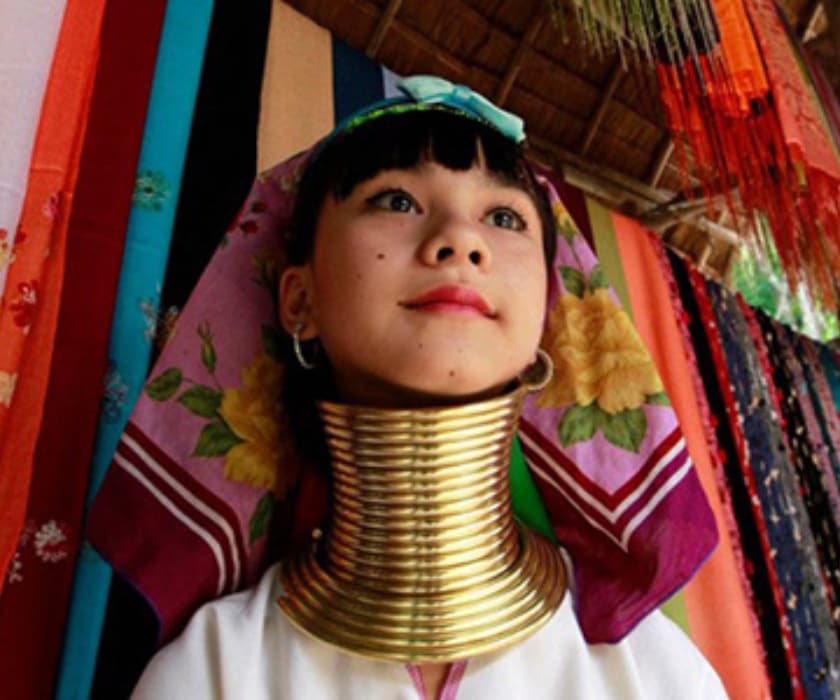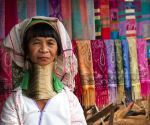The Karen Hill Tribes of Chiang Mai
The Karen Hill Tribes represent one of the region's most distinct and vibrant indigenous groups. In Chiang Mai and its neighbouring provinces, the Karen communities are known for their deep connection to the natural environment, rich cultural traditions, and remarkable resilience. Comprising various subgroups such as the Sgaw, Pwo, and Pa’O, each with its own language and customs, the Karen people maintain a lifestyle that reflects their ancient heritage and responds to modern challenges.
Understanding and preserving the cultures of indigenous tribes like the Karen is crucial not only for the sake of cultural diversity but also for the invaluable knowledge they offer in sustainable living and environmental stewardship. These communities hold key insights into living in harmony with nature, insights that have sustained them for centuries. As the world grapples with environmental degradation and cultural homogenisation, embracing and supporting such diverse cultural landscapes becomes increasingly apparent.

The Karen
The Karen people represent one of the largest and most diverse ethnic minority groups in Southeast Asia, with a significant population residing in the highlands of Northern Thailand, particularly around Chiang Mai. Their origins can be traced back to the Tibetan Plateau, where they migrated through various regions over centuries before settling in their current locations in Thailand and parts of Myanmar. This long migration history has contributed to the rich cultural tapestry and linguistic diversity among the Karen.
Ethnic Background and Subgroups
The Karen are divided into subgroups with distinct languages, traditions, and social structures. The three primary subgroups include:
- Sgaw Karen:
Often referred to as White Karen, the Sgaw are the largest subgroup within the Karen community in Thailand. They are known for their vibrant and intricately woven tunics worn by women, which are a significant part of their identity. The Sgaw language, part of the Karenic branch of the Tibeto-Burman languages, is the most widely spoken among the Karen subgroups.
- Pwo Karen:
The Pwo, or Plong, can be divided into Eastern and Western Pwo. This subgroup is recognised for its unique linguistic contributions and traditional practices that differ slightly from the Sgaw. The Pwo Karen are mainly known for their musical traditions and the weaving of intricate patterns that tell stories of their heritage.
- Pa’O Karen:
Although smaller in number, the Pa’O have a distinct cultural identity, often characterised by their dark indigo-dyed clothes and the turban-like headgear worn by both men and women. The Pa’O have their language, which, like other Karen languages, is part of the Karenic language group but features unique lexical and syntactic structures.
The Karen predominantly inhabit the mountainous areas along the border with Myanmar, with a considerable population in Chiang Mai and the surrounding provinces such as Mae Hong Son, Chiang Rai, and Tak. These regions are characterised by rugged terrain and dense forests, which historically provided the Karen with the resources necessary for their traditional livelihoods based on rotational agriculture and forest foraging.
The Karen villages in these areas are often remote, accessible only by foot or rough roads, allowing them to maintain a degree of isolation and thus preserve their unique way of life amid Thailand’s rapid modernisation. However, this isolation also poses challenges, particularly regarding access to modern amenities, healthcare, and education.
History of the Karen in Thailand
The Karen's presence in Thailand is deeply entwined with the broader migratory patterns of Southeast Asia's ethnic groups, which have unfolded over centuries. Their history in the region illuminates a complex tapestry of movement, settlement, and interaction with Thai society and government.
Migration History:
The Karen are believed to have initially lived in the Gobi Desert area, migrating southward through China and into the mountainous regions that now comprise modern-day Myanmar and Thailand. This migration is thought to have started around 2000 B.C., although the Karen trace their roots in Thailand much further. Over centuries, as they moved southward, various Karen subgroups settled in the highlands of Northern Thailand, often in remote areas that allowed them to maintain their traditional lifestyles and autonomy.
The significant migration waves, particularly during and after the Burmese kingdoms' expansion periods in the 18th and 19th centuries, saw the Karen escape conflict and search for new arable lands. These migrations were characterised by voluntary movements and forced displacements, a pattern that has continued into recent decades due to political instability in Myanmar.
Historical Interactions:
Historically, the Karen's relationship with the Thai state has been complex and multifaceted. In the early stages of their history in Thailand, the Karen lived relatively independently, governed by their traditional laws and leaders. However, as the Thai government consolidated control over the highland areas in the 20th century, the Karen, like many other hill tribes, navigated a new relationship with a centralised authority.
During the mid-20th century, Thailand's national integration policies aimed to assimilate ethnic minorities, including the Karen. These policies included the introduction of the Thai language in education, conversion efforts by Christian and Buddhist missionaries, and the imposition of Thai cultural norms. However, the Karen have also been part of Thailand's border patrol forces, known as the "Tahan Phran" or Ranger forces, which align some Karen groups closely with national security interests.
Environmental and conservation policies have also influenced the relationship between the Karen and the Thai government. Since many Karen communities are located in or near areas now designated as national parks or protected areas, conflicts have arisen over land rights and traditional practices such as shifting cultivation. These issues have sparked both local and international advocacy efforts to secure Karen's land rights and their right to practice traditional agriculture.
Despite these challenges, the Karen continue contributing to Thailand's cultural and social mosaic, retaining their unique identity while interacting with government policies and modern economic opportunities.
Cultural Identity and Traditions
The Karen tribes of Chiang Mai are celebrated for their rich cultural identity, vividly expressed through their languages, traditional dress, weaving practices, and vibrant cultural rituals. These elements define their community and reinforce the social bonds and continuity of their heritage.
Language and Dialects:
Language is an integral part of Karen cultural identity. The Karen languages, belonging to the Tibeto-Burman language family, are divided into three major groups: Sgaw, Pwo, and Pa’O, each with its dialects. These languages encapsulate the oral traditions, histories, and knowledge of the Karen people. The linguistic diversity among the Karens highlights their historical migrations and settlements and their interactions with neighbouring cultures and tribes.
Traditional Dress and Weaving:
Traditional Karen dress is another critical aspect of their cultural identity, and weaving is considered an art form passed down through generations. Women traditionally engage in weaving, creating intricate patterns specific to their subgroup. The textiles often feature natural dyes made from local plants and minerals, reflecting their deep connection to their environment.
The dress varies between subgroups. Still, it commonly includes tunics, sarongs, and headscarves, each adorned with distinctive patterns and colours that signify the wearer’s marital status, community role, or festive occasion. These garments are particularly prominent during important events such as weddings, funerals, and religious ceremonies, underscoring their cultural significance.
Cultural Rituals, Festivals, and Music
Karen cultural life is rich with rituals and festivals that mark important agricultural cycles, religious beliefs, and community milestones. One of the most significant festivals is the "Karen New Year," celebrated with dance, music, and elaborate feasts, coinciding with the end of the rice harvest. This festival celebrates the new year, fosters community bonds, and passes on traditions to the younger generations.
Religious rituals often blend animist beliefs with elements of Buddhism or Christianity, depending on the subgroup. These rituals might involve offerings to spirits of the land to ensure a bountiful harvest or to honour ancestors considered guardians of their families.
Music and dance are integral to Karen festivals and rituals, featuring traditional instruments like drums, flutes, and the unique Karen harp. Music accompanies celebrations and everyday activities, serving as a medium for storytelling and expression of communal identity.
The Karen's cultural practices are not relics of the past but vibrant and evolving expressions of a community that values its heritage while navigating the challenges of the modern world. Through their language, dress, and cultural festivals, the Karen continue to affirm their unique identity and contribute richly to the multicultural tapestry of Northern Thailand.
Social Structure and Community Life
The Karen people's social structure is deeply rooted in their community life, reflecting a system emphasising family, respect for elders, and collective living. This structure is crucial in maintaining social cohesion and cultural continuity, particularly in the remote highland areas of Chiang Mai, where many Karen communities reside.
Family and Social Hierarchy:
Family is the fundamental unit of Karen society, often extended and including multiple generations living under one roof. These family units are part of larger clan systems, which play a significant role in social organisation, marriage arrangements, and communal responsibilities. The Karen’s social hierarchy is traditionally based on age and gender, with elders respected for their wisdom and experience and gender roles clearly defined. However, these are evolving with modern influences.
Inheritance and succession practices typically favour males, although land and property are often used collectively within families. This collective approach helps ensure the entire family's welfare and strengthens ties within the community.
Community Leaders and Elders:
Community leaders and elders hold significant authority within Karen villages. These leaders are often chosen based on their knowledge of tribal laws, dispute-resolution skills, and ability to communicate with external authorities, including government officials. Elders are crucial in decision-making processes, particularly in matters that affect the whole community, such as land use, community rituals, and interactions with non-Karen groups.
Elders also play a pivotal role in preserving oral histories and cultural knowledge passed down through storytelling and participation in rituals and festivals. Their wisdom is essential in maintaining the cultural identity and continuity of the Karen people.
Community and Collective Living:
The Karen have a strong sense of community, evident in their collective farming practices, communal eating, and cooperative efforts to build and maintain village infrastructure. This collective ethos extends to religious and social gatherings, essential for reinforcing community bonds and cultural identity.
Collective living is a practical approach to survival in often harsh environments and a reflection of Karen's worldview, which values harmony with nature and each other. This approach ensures that all community members, including the elderly, the sick, and the poor, are supported.
Community life among the Karen is characterised by mutual aid and cooperation, essential for their resilience and sustainability. These values are instilled from a young age, ensuring that each generation understands the importance of community and its role in its preservation.
Sustainable Living and Agriculture
The Karen have long exemplified sustainable living through traditional agricultural practices, hunting, fishing, and foraging. These activities sustain their communities nutritionally and play integral roles in their cultural rituals and social structures. However, modern challenges necessitate adaptations to these age-old practices.
Traditional Farming:
The Karen are predominantly subsistence farmers who utilise a form of rotational farming known as swidden agriculture or slash-and-burn. This method involves clearing a piece of forest for cultivation, using it for a few years until fertility declines, and then allowing it to regenerate over time. This cycle helps maintain soil health and forest biodiversity, reflecting a deep understanding of ecological balance.
Hill rice cultivation is another hallmark of Karen agriculture, tailored to the steep terrains they often inhabit. Unlike the paddy rice farming common in other parts of Thailand, hill rice does not require extensive flat fields or significant water inputs, making it suitable for the mountainous landscapes of Northern Thailand.
Hunting, Fishing, and Foraging:
Hunting, fishing, and foraging are traditional practices that provide supplementary food and medicinal resources for the Karen communities. These activities are governed by detailed local knowledge and customs that dictate how and when to harvest resources to avoid depletion. For instance, certain areas may be designated as no-hunting or no-fishing zones for periods to allow animal and fish populations to recover.
The Karen also use a wide range of forest-derived products for medicinal purposes, adhering to sustainable harvesting methods that ensure the long-term availability of these resources. This deep ecological knowledge is passed down through generations, often integrated into cultural teachings and practices.
Current Challenges and Adaptations:
While traditional practices have sustained the Karen for generations, modern challenges such as legal restrictions on land use, deforestation, and the encroachment of commercial agriculture are pressing the Karen to adapt. For example, national park and conservation laws can restrict traditional slash-and-burn agriculture, which is often misunderstood by policymakers as destructive.
In response, many Karen communities are adopting more "permanent" agricultural practices that can coexist with Thai agrarian policies. This includes introducing cash crops and using more intensive but sustainable farming techniques that do not entirely depend on forest clearing.
Moreover, there is an increasing movement among the Karen youth, who are often educated outside their villages, to bring back improved sustainable agricultural techniques and integrate them with traditional knowledge. They also leverage technology and new farming methods to increase productivity without compromising their ecological principles.
Religious Beliefs and Practices
Religion plays a central role in the life of the Karen people, permeating many aspects of their daily activities, community organisation, and cultural practices. Predominantly adherents of Animism, Christianity, and Buddhism, the Karen's religious diversity is a testament to their rich historical interactions and adaptability.
- Animism:
Traditional Karen religion is rooted in Animism, which involves the belief that natural objects, phenomena, and human creations possess a spiritual essence. Animists believe that spirits inhabit the trees, rivers, mountains, and even tools, and these spirits can influence the well-being and luck of the Karen people. Rituals and offerings are standard practices to appease these spirits, ensuring harmony within the community and their environment.
- Christianity:
Introduced by Western missionaries in the 19th century, Christianity has been adopted by a significant portion of the Karen population, particularly among the Sgaw Karen. Christian Karen often integrates their new religious beliefs with traditional customs, leading to unique hybrid practices. Churches serve as essential community centres where social issues are discussed and communal decisions are made.
- Buddhism:
While less common than Animism and Christianity, Buddhism is practised by some Karen groups, particularly those who have had prolonged contact with the predominant Thai or Burmese cultures surrounding their communities. Buddhists participate in local festivals and may visit temples, blending Buddhist practices with their traditional beliefs.
Religion influences nearly every aspect of Karen life, from agricultural practices to festive celebrations and social norms. Religious beliefs often dictate the calendar of farming activities; for example, certain rituals must be performed before planting or harvesting crops to ensure a bountiful yield and avoid offending the land's spirits.
In Animist communities, ritual specialists and village elders play critical roles in conducting ceremonies and maintaining the balance between the spiritual and physical worlds. These rituals can include offerings of food and drink, animal sacrifices, and recitations that protect the community from evil spirits or ensure good health and prosperity.
Christian and Buddhist Karen also observe religious holidays and practices through church services or temple visits, reinforcing community bonds and providing spiritual guidance. For Christian Karen, Sunday services, Christmas, and Easter are significant, while Buddhist Karen observe days of merit and participate in local Buddhist festivals.
Moreover, religion affects social customs such as marriage, funerals, and naming ceremonies, each accompanied by specific rites that reflect the family’s religious background. These events are community affairs, often supported by collective labour, food, and money contributions, strengthening communal ties.
Challenges Facing the Karen Tribes
Despite their rich cultural heritage and deep connection to their ancestral lands, the Karen tribes in Chiang Mai and beyond face numerous challenges threatening their traditional way of life and sustainable practices. These challenges encompass issues related to land rights, education, and economic development, each intertwining with the others in complex ways.
Land Rights Issues and Resource Control:
One of the most pressing issues for the Karen is the struggle over land and natural resources. Traditional Karen territories often overlap with national parks and protected areas, leading to conflicts with government conservation policies. The enforcement of these policies sometimes results in the displacement of Karen communities and restrictions on their traditional agricultural practices, such as rotational farming and foraging, which are often misunderstood and labelled as environmentally harmful.
Additionally, the lack of formal land titles complicates their claims to land ownership, making it difficult for them to secure legal recognition and protection under Thai law. This situation leaves many Karens vulnerable to land grabs and exploitation by outside interests, including logging and mining companies seeking to capitalise on the rich natural resources within their ancestral lands.
Education and Language Challenges:
Education poses another significant challenge for the Karen. While Thai government initiatives aim to integrate hill tribe children into the national education system, these efforts often overlook Karen students' unique cultural and linguistic needs. The language barrier is a significant hurdle, as many Karen children speak their native languages at home and struggle with Thai, the language of instruction in schools. This disconnect can lead to high dropout rates and limited access to higher education and employment opportunities.
Cultural assimilation pressures within the education system further alienate Karen students, who may find their customs and traditional knowledge undervalued or ignored in the curriculum. There is an urgent need for culturally inclusive education policies that respect and incorporate Karen languages and cultural practices, enhancing learning outcomes and fostering greater integration.
Economic Challenges and Development:
Economically, many Karen communities rely primarily on subsistence farming, which is vulnerable to weather and market fluctuations. Their limited access to broader markets for their agricultural products and handicrafts restricts their income potential and perpetuates cycles of poverty. However, there are emerging opportunities for economic development, mainly through community-based tourism and the marketing of traditional Karen textiles and other crafts.
When appropriately managed, sustainable tourism initiatives can provide Karen communities with a vital source of income and a platform to educate others about their culture and sustainable practices. These initiatives must be developed in collaboration with the communities to ensure they are beneficial and respect the Karen’s way of life.
Tourism and Its Impact on the Karen Communities
Tourism, particularly eco-tourism and cultural tourism, has become increasingly significant for the Karen communities in Chiang Mai and surrounding areas. While it presents opportunities for economic development and cultural preservation, tourism also brings challenges that need careful management to ensure the communities benefit sustainably and ethically.
Eco-tourism and cultural tourism initiatives within Karen villages are often designed to showcase the unique artistic practices and sustainable living methods of the Karen people. These tourism models focus on creating immersive experiences for visitors, who learn about traditional farming techniques, weaving, and the rich spiritual life of the Karen. By sharing their heritage, the Karen can generate awareness and appreciation for their culture, potentially leading to advocacy and support for their rights and traditions.
These tourism activities can also provide the Karen with a significant source of income. By hosting tourists, selling crafts, and offering guided tours of their lands, the Karen can diversify their income beyond subsistence farming and contribute to community projects, such as building schools or improving infrastructure.
Tourism can bring economic benefits but has potential drawbacks. An influx of tourists can lead to cultural disruption, environmental degradation, and a shift in traditional values. For instance, the demands of continuous tourist visits can strain local resources and lead to commercialising cultural rituals and practices, which may lose their intrinsic meanings and become performances for an audience.
Moreover, without proper regulation, tourism can lead to unequal income distribution within communities, creating disparities and possibly leading to conflicts among community members. External operators can also control tourism activities without adequately involving or compensating the Karen, thereby limiting the community's benefits.
Ethical Considerations:
Tourism must be managed ethically with respect for the Karen’s way of life and environment to be beneficial and sustainable. Tourists can play a crucial role in this by following best practices during their visits:
- Respectful Engagement:
Tourists should approach Karen communities respectfully, seeking permission before taking photographs, participating in rituals, or entering sacred spaces. Learning a few phrases in the Karen language can also show respect and goodwill. - Support Local Enterprises:
Purchasing handicrafts directly from artisans, eating at local eateries, and using services provided by the community help ensure that tourism dollars benefit the residents directly. - Environmental Awareness:
Visitors should follow guidelines to minimise ecological impact, such as disposing of waste properly, staying on designated paths during treks, and using water sparingly. - Cultural Sensitivity:
Understanding and respecting the Karen’s customs and traditions is crucial. Tourists should dress modestly, behave appropriately during cultural performances, and avoid imposing their beliefs. - Choose Responsible Tour Operators:
Tourists should select operators that work directly with Karen communities, provide fair wages, and prioritise the welfare of the community and the environment. Our concierge at akyra Manor Chiang Mai will arrange ethical tours to Karen Hill Tribes and Chiang Dao Cave.
The Future
The future of the Karen communities in Chiang Mai hinges on sustainable development, cultural preservation, and successful adaptation to global changes. Various initiatives and projects and the active involvement of NGOs, government bodies, and the Karen youth are crucial in shaping a resilient future that respects and maintains Karen heritage while addressing contemporary challenges.
Several initiatives are underway to support the sustainability and cultural preservation of Karen communities. These include community-based tourism projects that help Karen villages manage tourism sustainably, agricultural cooperatives that promote organic farming and fair trade practices, and cultural workshops that teach Karen crafts and traditions to tourists and younger members of the tribe.
Education projects incorporating Karen languages and cultural knowledge into the curriculum are also significant. These programs aim to reduce educational barriers and improve literacy rates within Karen communities, ensuring that children can succeed in both their traditional and modern societal roles.
NGOs play a critical role in advocating for Karen rights, providing legal assistance for land claims, and bringing international attention to the Karen's challenges. They also facilitate development projects, from improving access to clean water and healthcare to offering vocational training and financial support for Karen artisans.
Government bodies have the authority to enact and enforce policies that can significantly affect the Karen. Recognising Karen land rights, supporting culturally inclusive educational programs, and including Karen representatives in political processes are essential for the Thai government. Additionally, conservation policies should be designed in consultation with Karen communities to ensure that environmental protection efforts do not inadvertently undermine the Karen's traditional ways of life.
The younger generation of Karen holds the key to the tribe's future. While they face the pull of modernisation and urban opportunities, many young Karen are finding ways to blend their traditional heritage with modern practices. Through education and technology, they are positioning themselves as cultural ambassadors who can navigate both worlds.
Young Karen is increasingly involved in cultural preservation through digital media, documenting their traditions and advocating for their rights on social platforms. They are also instrumental in translating the sustainable practices of their ancestors into contexts relevant to current environmental challenges.
By engaging with the global community, the Karen youth are redefining what it means to be Karen in the modern world. They are at the forefront of developing new economic models that respect their cultural heritage, advocating for policies that protect their communities, and ensuring that Karen's voice is heard in national and international arenas.
Related Articles
- Family Friendly Fun in Chiang Mai
- National Parks and Gardens in Chiang Mai
- Explore Chiang Mai Customs and Culture
- Discover The Real Chiang Mai
- Chiang Mai Concierge Recommendations
akyra MANOR CHIANG MAI HOTEL
22/2 Nimmana Haeminda Road Soi 9,
Su Thep, Muang Chiang Mai District,
Chiang Mai 50200, Thailand
T : +66 (0) 5 321 6219
M: Location
Others Blog
Latest Post
The Karen Hill Tribes of Chiang Mai
22/04/24Extend Your Stay in Chiang Mai
01/04/24



